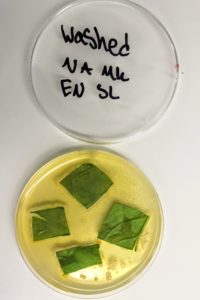Grade 9: Interdisciplinary Science I
Grade 9: Interdisciplinary Science I
The freshman year in the School for Science and Math enables students to begin a journey of exploration and learning that will expand their understanding of what it means to be an active participant in science. The curriculum weaves together the sciences, technology, engineering, and mathematics through meaningful and engaging hands-on exploration with increasing depth and independence. Lessons emphasize the idea that science is a collaborative endeavor and that even the greatest scientists talk to and learn from their peers. Students are, therefore, expected to ask questions and contribute their own insights, whether engaged in a lesson with SSMV faculty or when meeting with members of the Vanderbilt faculty, post-doctoral fellows, graduate students, or experts beyond our university borders. The 9th grade curriculum embraces the interdisciplinary nature of science by investigating questions through various genres of science.
Examples of the descriptions for a couple of days in the Interdisciplinary Science I curriculum:
- How Many Species Do You Support?
All of life on Earth is connected and related through the tree of life. In this interactive day, we expand o
Students measure the presence of microorganisms in washed spinach leaves. ur inquiry from a previous lesson on the diversity of life itself, to the diverse nature of the interactions of living organisms. We will use the students’ observations of biodiversity in their own environments to launch into our core lesson focusing on the interrelatedness of organisms, including the concepts of competition, predation, mutualism, and parasitism. We will extend this discussion to examine types of organismal interactions that happen in our own homes. In an activity designed to strengthen student skills in creating and testing a good hypothesis, students will design their own experiments to investigate the presence and abundance of microorganisms on the food that we consume. We will discuss those microbes that we cannot live without as well as those that threaten our health, asking why some bacterial strains make us so sick while others are so innocuous? A guest scientist from Vanderbilt will visit the class and speak specifically about bacteria that can colonize in human stomachs and how this can be benign or harmful. Students practice their critical thinking, reasoning, and communication skills by engaging in a forum to address how to cure or prevent the infectious diseases that threaten global human health.
- Can Supercomputers Predict the Future?
This week we explore the world of computers and their importance in research here at Vanderbilt. We will begin with a dissection of a every day “computers”, like the ones found inside an old telephone or electronic toy, followed by an explanation of what’s inside these items and what purposes they serve. This will tie into a tour of Vanderbilt’s Advanced Computing Center for Research and Education (ACCRE) facility, a cluster of over 2,300 computer processors which is used for high end processing of information in numerous fields of study. After the tour, Dr. Jens Meiler, an investigator in the Department of Chemistry and frequent user of the ACCRE facility, will discuss his work in protein science and drug development and lead us through an interactive protein simulation program that scientists use to predict the properties of different proteins for better drug delivery.
In and outside of the classroom, students participant in hands-on explorations of STEM. Students explore Vanderbilt University labs to learn more about the cutting-edge research happening on campus and also participate in experiments in the classroom to learn and develop important laboratory techniques. Check out the pigment extraction lab video below, where students extracted pigments from fruits and vegetables and used that pigment to dye fabric.
In the summer following 9th grade, students will participate in the Summer Research I course.
CONNECT WITH SSMV